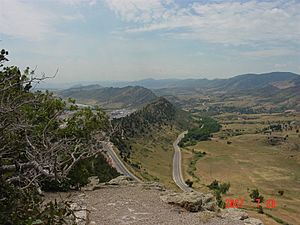Dakota Hogback facts for kids
Quick facts for kids Dakota Hogback |
|
|---|---|

The Dakota Hogback viewed south from the Dakota Ridge Trail at the crest of Dinosaur Ridge, just south of Interstate 70.
|
|
| Coordinates | 39°40′34″N 105°11′34″W / 39.676022°N 105.192688°W |
| Part of | Rock Mountain Front Range |
| Geology | Cretaceous Dakota Group sandstone and shale anticline |
| Orogeny | Laramide |
- North terminus: 41°29′04″N 105°15′18″W / 41.484347°N 105.254917°W
- South terminus: 37°37′11″N 104°56′51″W / 37.619759°N 104.947553°W
The Dakota Hogback is a long, narrow ridge of hills. It's found at the eastern edge of the Rocky Mountains. This ridge stretches from southern Wyoming through Colorado and into northern New Mexico. You can easily spot it as the first line of hills next to the Great Plains. Rivers have cut through it in many places. The ridge gets its name from the Dakota Formation, a type of sandstone rock that makes it up.
How the Hogback Formed
The Dakota Hogback was created about 50 million years ago. This happened during a major event called the Laramide orogeny. An "orogeny" is a fancy word for a period when mountains are formed. During this time, the modern Rocky Mountains were pushed up.
Before the mountains rose, this whole area was covered by a shallow sea. Over millions of years, things like oyster and clam shells, sand, and mud settled to the bottom. These layers were squished together to form soft sedimentary rocks. These rocks included sandstone, shale, and limestone.
As the Rocky Mountains slowly rose, the land to the west was pushed upwards. This caused the layers of rock to bend and tilt. The western edge of these tilted layers now stands at about a 45-degree angle. This is what we see as the Dakota Hogback.
The very top layer of the hogback is a hard rock called Dakota Sandstone. This strong sandstone protects the softer layers of shale and limestone underneath it. Without this hard top layer, the softer rocks would have worn away much faster.
Ancient Discoveries
Even though the hogback itself formed about 50 million years ago, the rocks that make it up are much, much older. These rocks hold secrets from a time long before the mountains existed.
For example, scientists have found dinosaur footprints in the exposed rock layers. These footprints were made by dinosaurs that lived during the Jurassic Period, about 150 million years ago! Some of these tracks were made by huge dinosaurs like the Diplodocus. You could even see some of these footprints on the hogback west of Denver, Colorado as recently as the 1980s. It's like a giant, ancient sidewalk!
A Natural Barrier
The Dakota Hogback acts like a natural wall. It separates the flat high plains from the Rocky Mountain foothills. For a long time, this ridge made it hard to travel between the mountains and the plains.
However, rivers have carved out gaps in the ridge over time. People have used these natural openings to build roads. These roads allow easy travel through the hogback. For example, Interstate 70 passes through a large cut in the ridge. If you drive through it, you can see all the different layers of rock that make up the hogback.
The hogback runs parallel to Interstate 25 (I-25) for a long stretch. It's always to the west of the highway. Other major roads that cross the hogback include:
- Interstate 80 in southern Wyoming.
- U.S. Route 34 near Loveland, Colorado.
- U.S. Route 36 which leads towards Rocky Mountain National Park.
- U.S. Route 24 in Colorado Springs, Colorado.
- U.S. Route 50 in Pueblo, Colorado.
- U.S. Route 160 in Walsenburg, Colorado.

